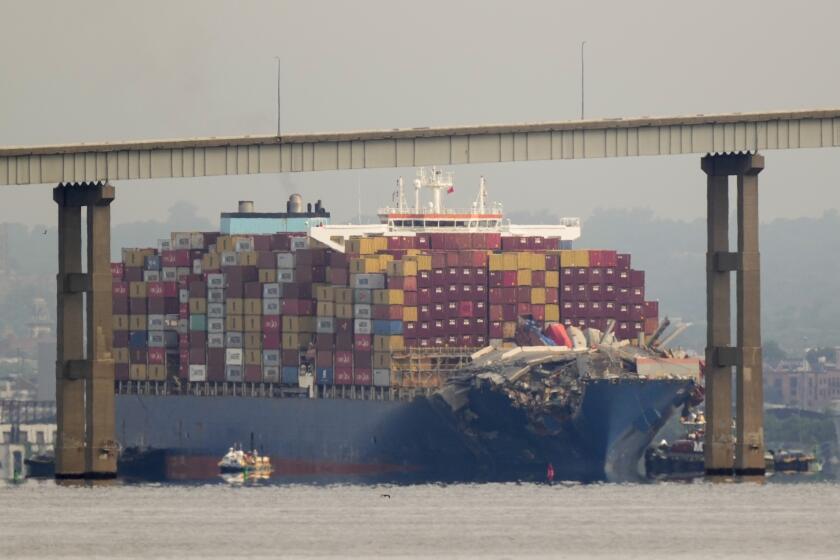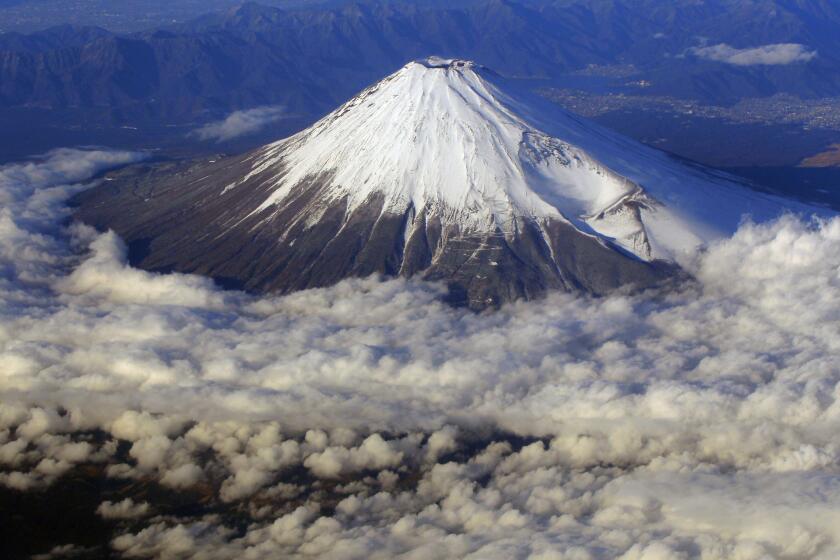Storm Breach Sows Division in Cape Hatteras
Just above this tiny village, on North Carolina’s wind-swept barrier islands, the pounding waves of Hurricane Isabel opened a channel that has become a test of the human will to live by the beach, that most ephemeral of habitats.
The 1,700-foot-wide channel has severed Highway 12, the only road that links the town of 1,550 year-round residents to the rest of the Outer Banks and the mainland. Hatteras, which has a new shipwreck museum, had been hoping for a bigger share of the area’s rich tourist economy before Isabel.
Calling the channel a “breach,” local, state and federal authorities have launched a $2.7-million dredging project to quickly plug it. But environmentalists, calling the channel an “inlet,” are saying it may deserve a permanent place on the map, even a name.
Implicit in the environmentalist stance is the message that people who live by the beach may have to relinquish some certainties and conveniences of modern life. In the West, there are similar debates about whether taxpayers should bail out those who build on Pacific bluffs or on land prone to wildfires when disaster strikes.
“Hurricanes have become an urban renewal project,” said Orrin Pilkey, a coastal geologist at Duke University.
In North Carolina, officials came up with an emergency plan to rebuild Highway 12 by pumping up to 1 million cubic yards of sand dredged from nearby shoals to close the channel, then laying new blacktop. The federal government agreed to pay for the dredging, and the gear is already on its way. Permits for the dredging are on a fast track, and the project is slated to be finished in 30 days.
Environmentalists say authorities should consider alternatives such as ferry service to the village, or a bridge, a costlier and more time-consuming option than dredging.
“We are totally supportive of quickly getting a transportation route to the island,” said Jane Preyer of Environmental Defense in Raleigh, the state capital. “But there has been absolutely no examination of alternatives to filling the inlet.”
The channel’s opening to the sea could help flush and refresh the waters of Pamlico Sound, which lies between the islands and the mainland, environmentalists say.
“You could have some real benefits for the fishing industry and the health of the sound, that at least should be looked at,” Preyer said.
So far, North Carolina officials have not been persuaded. The residents of Hatteras “don’t have helicopters and sailboats,” said Rolf Blizzard, an aide to state Sen. Marc Basnight, a Democrat who represents the area. “You’ve got to provide access, and you’ve got to put back the access that was there.”
Nature preserve and vacation paradise coexist in tension on the Outer Banks.
The area is designated a national seashore, and large stretches are run by the National Park Service. But splendid vacation homes -- called “rental machines” by the locals -- keep going up along the coast, bringing traffic and demands for services, as well as creating jobs.
Environmental groups have called for a moratorium on new construction along the coast in the wake of Isabel.
Hatteras village, with 111 buildings destroyed or declared uninhabitable, was hammered by the hurricane like no other nearby community. Although phone service and power have been restored, and plenty of drinking water and food is available, many residents are feeling isolated and vulnerable.
“It’s scary,” said Debbie Hodge, 51, a Hatteras native who lost her home in the hurricane. The road was “our only way out, our lifeline. It would be easier for us if they filled it in and put a new road down.”
Hodge wonders what would happen if she developed complications from her diabetes. “The way it is now, I’d have to get flown out if I had a health problem,” she said.
Without the highway, children in Hatteras have no easy way of getting to school in a village farther north. And their parents can’t hop in cars and drive to work in the bigger towns.
“Clearly, we don’t need another inlet,” said John Robert Hooper, a Dare County commissioner who represents Hatteras. “I’ve read some of those environmental narratives and I can shoot them full of holes.”
Right now, it is the town that has been punched full of holes. Mounds of scrap are all that’s left of some houses. The roof of one home juts out from the waters of the sound, more than a quarter-mile from where it originally stood. Household appliances ruined by flooding line the streets.
Though weary and exasperated, residents say they have seen the village come together.
The Rev. Charles Moseley, pastor of Hatteras United Methodist Church, said he told his congregation that he would never again stress the differences that distinguish his own denomination, but rather promote unity among all churches. “From now on we’re just the Christian people on Hatteras,” he said.
Jesus Coronel came to Hatteras to work in a hotel a few days before Isabel arrived. Originally from Tabasco, Mexico, he said he has felt accepted a long way from home. “A lady came up the other day and said, ‘There are no differences here. Mexicans and Americans are the same,’ ” Coronel said.
While damaging to human communities, the storm may actually have enhanced some natural habitats -- hurricanes and nor’easters have always been the engineers of the beauty of the Outer Banks.
Sidney Maddock, an analyst with the Center for Biological Diversity who lives in the Outer Banks village of Buxton, is fascinated with a phenomenon called “overwash fans.” The large, fan-shaped areas of fine sand were created far inland when the sea burst through the dunes during Isabel. In some places, the sand is 3 to 4 feet deep. These sand deposits could become nesting places for the piping plover and other threatened birds that build their nests in the open, Maddock said.
“If you spoke to ornithologists, the conclusion could well be that this area is better for birds now than before the storm,” said Maddock.
But some of the overwash fans have covered Highway 12. On a drive down the road, bulldozers could be seen clearing the sand. It is being used to rebuild the dune, which is actually an artificial storm barrier.
Farther down the island chain in Hatteras, workers have been boring under the new inlet to bring a water pipe and electricity and cable television connections to the village. Power is now being provided by an emergency generator. Strong currents could be seen swirling through the channels of the inlet, and some see promise in them for Pamlico Sound.
“A new inlet will improve water quality,” said James Fletcher, an advocate for the local fishing industry. “If you are in the fishing industry or you’re interested in water quality, what you want to see here is a bridge.”
But officials have closed ranks behind the quicker, cheaper option of dredging and filling, he said. “There’s not a judge in the state of North Carolina who would rule against it,” said Fletcher. “It’s going to be greased, and it’s going to go through like a rocket sled on rails.”
When Hurricane Isabel cut the new channel north of Hatteras village, it uncovered the pilings of an old bridge, buried and all but forgotten by locals. It turns out that an inlet had existed in the same spot in the distant past.
More to Read
Start your day right
Sign up for Essential California for news, features and recommendations from the L.A. Times and beyond in your inbox six days a week.
You may occasionally receive promotional content from the Los Angeles Times.






